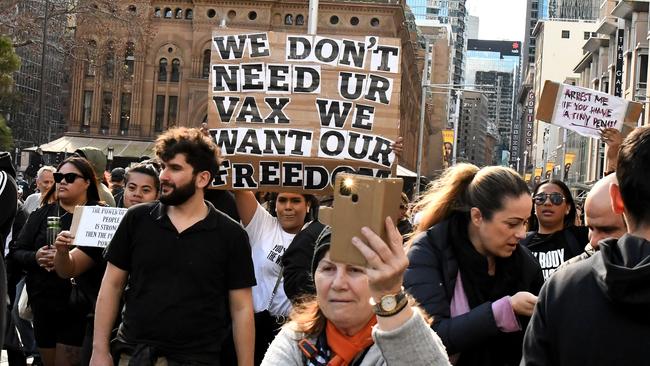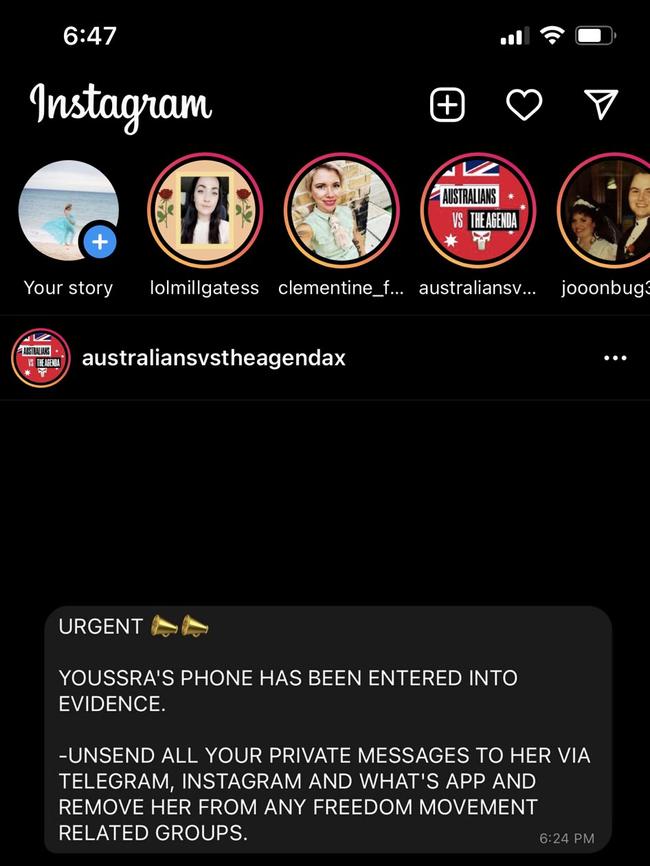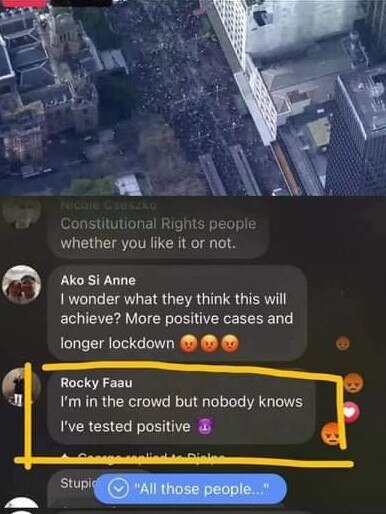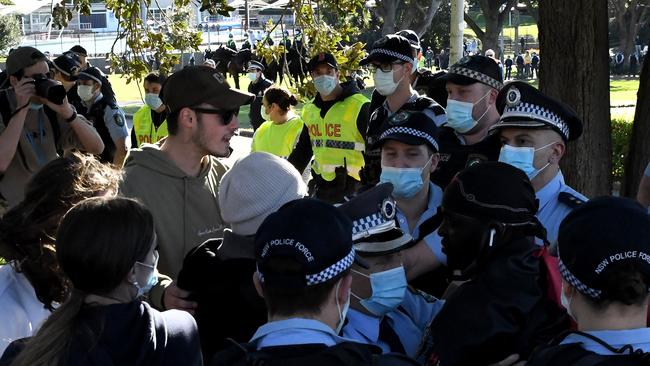
One of the organisers of the Melbourne rally, Anthony Khallouf last night sent out an APB on his Instagram account, Australians v the Agendax, urging his followers to delete correspondence with Youssra, another anti-lockdown activist who had been arrested and had her mobile phone confiscated by police.
The urgent message read, “Unsend all your private messages to (Youssra) via Telegram, Instagram and What’s App and remove her from any freedom related groups.”
Khallouf is believed to be in Queensland in breach of his own bail conditions. He was charged with incitement among other offences, including contravene bail conditions some time ago.
I watched the Sydney protests as they unfolded through a series of Facebook Live videos. One of the things that distinguished the protest on the weekend with others is that these protesters happily filmed themselves and others committing offences. Watching them on live feeds was, as the sports broadcasters like to tell us, almost better than being there.
The most alarming message of all turned up on Instagram from an anonymous poster. “I’m in the crowd but nobody knows I’ve tested positive.” It is probably empty mischief but who knows? I guess we all will in a week or two.


Let’s start with a few basic principles. Australians have a constitutional right to political expression.
We don’t have to agree with protesters, but we should agree to their right to assemble peacefully even during a pandemic. The problem is this was not a peaceful assembly. More than fifty arrests were made, more than 500 personal infringement notices were handed out or are in the mail with more to come. Projectiles were hurled at police (in New South Wales this constitutes a form of assault police and comes with a maximum five year jail term. In Melbourne there is a mandatory minimum jail sentence of six months without parole for assaults on police and emergency services workers).
For those in the whataboutery business, the BLM protest in Sydney in June 2020 was deemed a lawful assembly by the NSW Court of Appeal and thus no PINs were issued. Only three arrests were made with a final confrontation between police and protesters coming together at Central Station where approximately 40 protesters were washed down with pepper spray.
For what it’s worth, I thought both protests were incredibly irresponsible but overall, I take the Voltairean view with some caveats.
The anti-lockdown protests on Saturday were planned and signposted by the usual suspects; extreme fringe groups — anti-lockdowners, anti-vaxxers, sovereign citizens.
I’d watched them promote the rallies throughout last week. I thought they might struggle to get more than a couple of thousand along. This had been the case for anti-lockdown rallies in Sydney last year. Obviously, this crowd was a lot bigger, around 15,000 by my estimate. Organisers claimed 50,000. One excitable voice on Telegram suggested one million marchers.
There were few placards at Saturday’s rally and that says the decision to march was made impulsively for the majority of protesters. Not enough time to get to the craft shop for all the bits and bobs to make an amusing placard.
So, who were the protesters? Beyond the usual suspects, it was an eclectic group – construction workers, Pentecostal Christians, and a strong Muslim element. There was a smattering of QAnon hobby cultists. There were members from the broad spectrum of the ‘wellness’ community, not simply diet faddists but mixed martial arts enthusiasts, powerlifters, gym junkies. All the colours of the wellness rainbow. There were at least two school teachers, and both are in a spot of bother with their employers. There were protesters from the libertarian right, some of whom proudly boasted receiving PIN notices, a bit like parking the Porsche in a handicap zone. A fine? Who cares?
The sovereign citizen movement unhelpfully suggested to those who received PINs to respond by sending the envelopes back to police with the following bush lawyer nonsense scrawled on the envelope: “No contract. Return to sender. I do not recognise you. I do not understand your intent. I do not have an international treaty with you. No assured value. No liability.”
No one goes to jail for non-payment of fines in New South Wales. Fines are merely sent on to the State Debt Recovery Office and where fines go unpaid, suspension of driver’s licences follow until the fines and costs are paid. I can only imagine there will be a lot more unlicensed drivers on the road in Sydney in six months than there are now.

The surprisingly large number of protesters offers a lesson for NSW Police. VicPol has had a longer experience with what we might broadly call anti-lockdown activists. It has become apparent to me that VicPol has had a significant number of officers working social media, developing intel. It’s not hard. Activists use Instagram and Telegram where they boast and brag of their plans. NSW Police will be better prepared for the next rally when that happens.
There were plenty of troublemakers, but the number swelled due to the fear and anxiety that has arisen from the lockdown and the failure to provide people with any or any appropriate level of income support to see them through. In that respect it was a genuine protest, with many concerned for their futures, and the fundamental business of keeping roofs over heads and food on tables.
The real issue is that these protesters in many instances became subject to the influence of extreme fringe groups for the first time. Many will have fallen into their orbit now.
I keep trying to tell people how serious these fringe groups are and what threats they pose. We all know the best way forward in Sydney and more broadly across the nation is high levels of vaccination.
How much influence anti-vaxxers have in Australia necessarily affects the level of vaccination we get in the medium term. Will we become like the UK with high levels of vaccination, enough to open up our international borders and feel secure that most of the population is as well protected as possible against Covid-19 and its variants or will we go down the US route where impressive early vaccination figures have hit a brick wall and now stand at a desultory 70 per cent, an expression of the political divisions in the US if ever there was one?
We’re about to find out whether we are a smart country or not. We’ll know by the end of the year, but the events of the weekend suggest we might be in for a rude shock.



If you listened carefully in the wake of the anti-lockdown protests across Australia over the weekend, you could hear hundreds of social media accounts being wiped clean or deleted altogether.